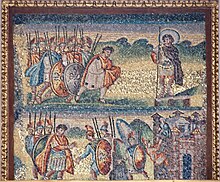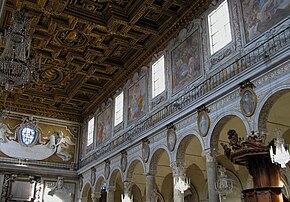Church painting
The church painting is part of the Christian committed fine arts ( Christian art ) and has its origins in the developed around the year 200 catacomb in Rome and Naples . “ Church painter ”, on the other hand, is the name commonly used today for the handicraft-oriented profession of painter and varnisher , specializing in church painting and monument preservation .
General
Pictorial representations with their forms of expression shaped by the respective surrounding cultural and artistic landscape can only be recognized as Christian in the context of art history in terms of their iconography (content interpretation); there was never an independent Christian style as such. The early wall paintings in church choirs and devotional chapels were primarily aids to understanding for those unfamiliar with reading. In the Middle Ages, the related equipment options were expanded to include Christian panel painting as painting on mobile substrates such as wood or canvas .
Church painting also includes the handicraft decorating of walls, ceilings and facades. Artists and craftsmen design and form ornaments and profiles, paint sculptures and create plastic jewelry in color. For this handicraft side there is now the teaching profession of church painter .
The old church
The theologians of the early church based their attitude in the first centuries AD on the prohibition of images in the Decalogue and were thoroughly hostile to artistic activities, especially painting. However, in the old Christian catacombs there are also pictorial representations from the area of Christian tradition. It was not until the 4th century that the didactic value of painting was slowly recognized, combined with the beginning of painting of saints for churches and private use. This development was promoted by society's reawakening need for pictorial vividness.
Byzantine church painting

The Byzantine art epoch refers to a period from the 4th century to the 15th century , the duration of the Byzantine Empire , which emerged in the late 4th century through the division of the Roman Empire into East and West Rome .
With the beginning of the recognition of Christianity as the state religion in the 4th century, painting served to decorate the great basilicas ; this includes wall paintings and mosaics on walls, ceilings and in domes. These first paintings followed on from antiquity in style and technique, although the individual motifs already had their own artistic expression. At the same time, a difference between occidental (Roman) and oriental (Byzantine) painting began to develop at this time, with Byzantine painting retaining the type of early Christian representations for the longest. It differs from the Roman representation in that it preferred a gold background. The figures appear rather "elongated" in Byzantine art, while figures in Roman painting are represented "shortened". Examples of designs of this type from the 5th century can be found e.g. B. in Rome in the Church of Santa Maria Maggiore and in Ravenna .
The still latent hostility to art in Byzantium led to the iconoclast in the 8th century . The artists fled to Italy until the Council of Nicaea of 787 and the Synod of Constantinople of 842 confirmed the permissibility of the pictorial representation of sacred objects. The orthodox doctrine of images as a mediator between this world and the hereafter, partaking in the sacred, was officially elevated to dogma . In Rome and in Western Catholicism, the pictures were regarded as the “bible of the laity”, but not as worthy of venerable; that could only be found in popular piety.
Byzantine painting preserved its expressiveness based on traditional craftsmanship and independent creativity until the 11th century. As a result, however, it froze in its conception of forms in a schematism. In its heyday, Byzantine art radiated particularly to Armenia and subsequently to Russia, where the Byzantine tradition has been preserved in church worship to this day.
It also had an impact on Italian art; Traces of Byzantine art can be found particularly in Sicily, Southern Italy, Genoa and Venice. Byzantine art had an impact even as far as distant Ireland ; The miniature painting in manuscripts for church use, which developed into a special art form in the monasteries, should be emphasized here. Also in the Franconian Empire, where Charlemagne founded a far-reaching school of painting in Aachen under the influence of Byzantine and ancient art and numerous centers of Carolingian illumination such as Saint-Amand , Fleury, Fulda, St. Gallen, Mainz, Metz, Saint-Omer , Tours, Reichenau, Reims, St-Vaast and others z. B. originated in Northern Italy, their effect extended. Both iconographically and stylistically, the influence of Byzantine and late antique models on the main works of Carolingian book illumination is unmistakable. Under the influence of Alkuin , an outstanding scholar of his time and most important advisor to Charlemagne, the so-called Frankish style later developed from this. Only sparse remains of Carolingian wall paintings have survived or have been documented in literature, partly in the centers already mentioned, partly elsewhere, for example in Müstair or Germigny-des-Prés (mosaic).
Romanesque style


Around 1000 AD, the mixture of the Frankish style, ancient views and Byzantine austerity developed into the Romanesque style. The Frankish style spread in England, France and Germany and was not only shown in miniatures, but also in mosaics, glass and enamel paintings and carpet knitting.
Italian painting still shows a Byzantine character in the early 13th century. Cimabue in Florence (1240–1302) and the somewhat later Duccio in Siena were the first masters who made significant progress towards the independence of Italian painting. Giotto di Bondone went even further in Florence (1276–1337), the actual founder of Italian painting, who broke through the last barrier of Byzantinism in terms of freedom and movement in composition.
As for painting in other countries, under the Carolingians almost all artistic activity was concentrated on miniature painting, which was mainly practiced in the monasteries. It was not until Heinrich I and the Ottonians that wall painting began to be cultivated as frescoes in addition to miniature painting, as evidenced by the large paintings in Bamberg Cathedral around the year 1000. It was around this time that stained glass was invented and enriched art. Little has remained of the various painting schools of the early days: in Lower Saxony the wall paintings in the Brunswick Cathedral, on the Rhine the wall paintings in the double church in Schwarzrheindorf near Bonn, some remains in the Ulm Minster , but mostly in Cologne, where the construction of the cathedral was a major one Number of artists united.
reformation
With the Reformation , the beginning of which is generally considered to be Martin Luther's publication of the 95 theses, which he circulated on October 31, 1517 as an attachment to a letter to the Archbishop of Mainz and Magdeburg , a profound change in the perception of art began. She put an end to the cult of the Madonna and saints that had prevailed in painting until then and replaced religious subjects with motifs from everyday life and nature. With this she prepared a wide and open field of activity for the now rapidly blossoming portrait, genre, landscape and still life painting.
The Protestant churches took different attitudes towards the acceptance of church painting. Reformed people like Zwingli , Calvin and Knox rejected them as idolatry . Luther , on the other hand, not only attributed value to the Bible illustrations, but also saw the pictures on church walls as an aid to preaching the spiritual message. That is why there is Protestant art only in Lutheranism.
The Catholic Church had reacted to the Reformation with the Council of Trento from 1545 to 1563, and there set the course for a renewal. In the course of this development, numerous churches, chapels and monasteries were rebuilt or the existing ones furnished with lavishly decorated altars, painting cycles and iconographic ensembles.
See also
literature
- Entry painting - The Christian painting . In: Meyers Konversationslexikon . Volume 11, 4th edition. Verlag des Bibliographisches Institut, Leipzig and Vienna 1894–1896, p. 150.
- Entry christian art . In: Meyers Enzyklopädisches Lexikon . Bibliographisches Institut, Mannheim / Vienna / Zurich 1973, Volume 5, p. 690.

